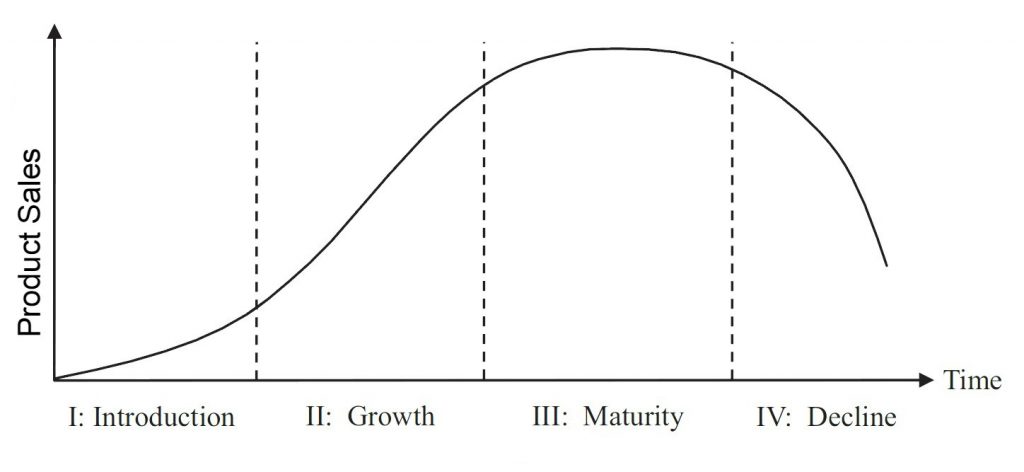Product Life cycle Stages
Product life cycle is the concept that is based on the idea that any product or service undergoes certain stages before disappearance. It enables a marketing manager examine the marketing mix of a particular product or basket of product in terms of its position in the life cycle.
To remain competitive, a company must adjust its strategy for the product or group of products, as the product, market and competitors change over the course of the product life cycle. For this to be true, we assume four things which are:
- Products cannot last forever, and at some point, they would decline or be non-existent
- The sale of products passes through different stages, each with its own risks, challenges, opportunities and problems to the seller.
- Profits rise and fall at different stages of the product life cycle
- Each stage of the life cycle is distinct, and with each stage, different strategies in marketing, financial, manufacturing, purchasing and human resources have to be adopted.
What then are the stages in the product life cycle?

Product life cycle diagram
There are four stages in the product life cycle. They are the introduction stage, growth stage, maturity stage and the decline stage. We would be taking a look at the stages in the product life cycle by using the marketing mix (4ps) to analyze them. Let us start first with the introduction stage.
Introduction stage:
The introduction stage as the name implies seeks to introduce the product to the market. It focuses more on promotion to increase product awareness, and by so doing gain entrance into the market. At this stage, the product or service is a drain on cash. Companies spend more on promotion to create awareness for their products.
This stage is characterized by slow growth, and high manufacturing costs and marketing costs. Most products or services, even the successful ones, lose money at this stage. Sales production expenditure will be heavy and the product price is important in determining the life cycle of the product. To sum it up using the marketing mix:
Product: At the introduction stage, product quality and features are established, and differentiation strategies such as branding would be adopted to differentiate the company’s product from the competitors’. If on the other hand the product is a pioneer product ie the first of its kind, then copyright and intellectual property protection such as patents would be established.
Pricing: Pricing strategies would be developed. The company may seek to recoup the money spent on R&D, and promotion fast by making the price high. If there is little product differentiation in the market for that product, then this strategy puts the company at a disadvantage as it would chase customers away from buying the product. Another strategy that a company seeking to introduce its product to the market can adopt is the reduction of prices below that of its competitors so as to gain its own market share.
Distribution (Place): Since the product is being freshly introduced and not yet popular, it would be distributed to limited places until it is widely accepted by the market.
Promotion: As previously discussed, companies spend more on promotion at the introduction stage to create awareness of the product.
Growth Stage:
This stage is characterized by an increase in sales and profits due to product or service awareness in the market. Money spent on research and development are fully recovered. Breaking It down by using the marketing mix:
Product: Product would have gained awareness, and the company finds ways to improve on the quality of the product
Pricing: Prices are slashed and other incentives are offered by competing firms, all in an attempt to obtain reasonable share of the market.
Distribution (Place): Reputable companies establish strong distribution channels in order to get effective control of their increased market share.
Promotion: Promotion in this stage is to a wider audience.
Maturity Stage:
At this stage, sales continue to grow with profit margin dropping as a result of competing. Let us take at the strategies likely to be adopted by using the 4p’s in the marketing mix.
Product: Differentiation strategies are intensified since there is increased competition; companies would look for whatever possible means of differentiating their products from the rest of the pack. Companies would generally be looking to improve the product or service.
Pricing: Prices are cut further, in order to hold on to their market share and prevent new competitors from stealing their customers.
Distribution (place): Distribution strategies are intensified. Incentives are given to ensure distribution, and deals to supply private brands may be struck.
Promotion: This stage is characterized by increased promotion expenditure, and product modifications are emphasized when promoting.
To sum up the maturity stage, the basic goal of a company at the maturity stage is to hold on to its market share. The company can still make profit depending on the strength of the economy. This may be achieved by product modification, market segmentation, or heavy sales promotion expenditure.
Decline Stage:
By the time a product or service enters this stage; its glamorous days are over. Demand at this stage has dropped and it is dangerous to increase investment on the product or services. Investment at this stage can only be at minimal level to maintain sales. The goal here would be to maximize short term benefits. Another strategy can be to discontinue the product completely, or divestment to other firms willing to bear the burden.
Hey there, why stop at this? Check out the product development process for a new product here: New Product development process
Recommended Readings
Philip Kotler., and Kevin Lane keller, Marketing Management (14th Edition)
Linda Gorchels., The product manager’s handbook
Alexander Chernev., Strategic Marketing Management






Leave a Reply